
A skeleton is the structural frame that supports the body of most animals. There are several types of skeletons, including the exoskeleton, which is a rigid outer shell that holds up an organism's shape; the endoskeleton, a rigid internal frame to which the organs and soft tissues attach; and the hydroskeleton, a flexible internal structure supported by the hydrostatic pressure of body fluids.

Sponges or sea sponges are members of the metazoan phylum Porifera, a basal animal clade and a sister taxon of the diploblasts. They are sessile filter feeders that are bound to the seabed, and are one of the most ancient members of macrobenthos, with many historical species being important reef-building organisms.

Hexactinellid sponges are sponges with a skeleton made of four- and/or six-pointed siliceous spicules, often referred to as glass sponges. They are usually classified along with other sponges in the phylum Porifera, but some researchers consider them sufficiently distinct to deserve their own phylum, Symplasma. Some experts believe glass sponges are the longest-lived animals on earth; these scientists tentatively estimate a maximum age of up to 15,000 years.
Spicules are any of various small needle-like anatomical structures occurring in organisms
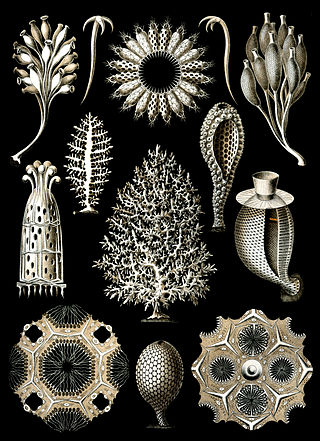
The calcareoussponges are members of the animal phylum Porifera, the cellular sponges. They are characterized by spicules made of calcium carbonate, in the form of high-magnesium calcite or aragonite. While the spicules in most species are triradiate, some species may possess two- or four-pointed spicules. Unlike other sponges, calcareans lack microscleres, tiny spicules which reinforce the flesh. In addition, their spicules develop from the outside-in, mineralizing within a hollow organic sheath.
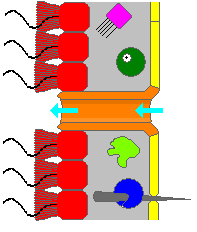
Choanocytes are cells that line the interior of asconoid, syconoid and leuconoid body types of sponges that contain a central flagellum, or cilium, surrounded by a collar of microvilli which are connected by a thin membrane.
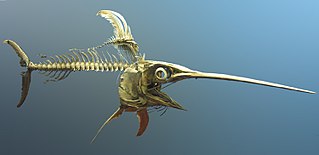
An endoskeleton is a structural frame (skeleton) on the inside of an animal, overlaid by soft tissues and usually composed of mineralized tissue. Endoskeletons serve as structural support against gravity and mechanical loads, and provide anchoring attachment sites for skeletal muscles to transmit force and allow movements and locomotion.

Intramembranous ossification is one of the two essential processes during fetal development of the gnathostome skeletal system by which rudimentary bone tissue is created. Intramembranous ossification is also an essential process during the natural healing of bone fractures and the rudimentary formation of bones of the head.

Demosponges (Demospongiae) are the most diverse class in the phylum Porifera. They include greater than 90% of all species of sponges with nearly 8,800 species worldwide. They are sponges with a soft body that covers a hard, often massive skeleton made of calcium carbonate, either aragonite or calcite. They are predominantly leuconoid in structure. Their "skeletons" are made of spicules consisting of fibers of the protein spongin, the mineral silica, or both. Where spicules of silica are present, they have a different shape from those in the otherwise similar glass sponges. Some species, in particular from the Antarctic, obtain the silica for spicule building from the ingestion of siliceous diatoms.
The mesohyl, formerly known as mesenchyme or as mesoglea, is the gelatinous matrix within a sponge. It fills the space between the external pinacoderm and the internal choanoderm. The mesohyl resembles a type of connective tissue and contains several amoeboid cells such as amebocytes, as well as fibrils and skeletal elements. For a long time, it has been largely accepted that sponges lack true tissue, but it is currently debated as to whether mesohyl and pinacoderm layers are tissues.
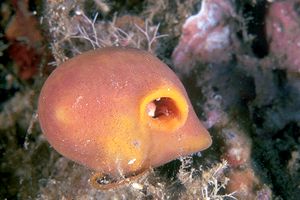
Suberites domuncula is a species of sea sponge belonging to the family Suberitidae.

Archaeocytes or amoebocytes are amoeboid cells found in sponges. They are totipotent and have varied functions depending on the species. The structure of these cells match to that of the stem cells as of containing high cytoplasmic content that helps the cells to morph according to their function.
Cliona californiana, the yellow boring sponge, boring sponge or sulphur sponge, is a species of demosponge belonging to the family Clionaidae. It is native to the north-eastern Pacific Ocean and burrows into the shell valves of bivalve molluscs.

Anheteromeyenia argyrosperma is a freshwater sponge found across North America.

Spicules are structural elements found in most sponges. The meshing of many spicules serves as the sponge's skeleton and thus it provides structural support and potentially defense against predators.

Suberites is a genus of sea sponges in the family Suberitidae. Sponges, known scientifically as Porifera, are the oldest metazoans and are used to elucidate the basics of multicellular evolution. These living fossils are ideal for studying the principal features of metazoans, such as extracellular matrix interactions, signal-receptor systems, nervous or sensory systems, and primitive immune systems. Thus, sponges are useful tools with which to study early animal evolution. They appeared approximately 580 million years ago, in the Ediacaran.
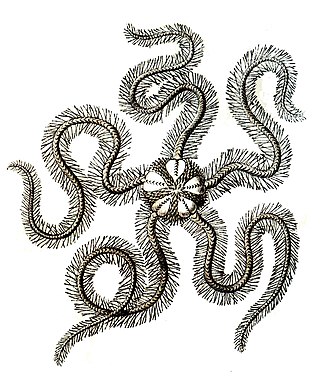
Ossicles are small calcareous elements embedded in the dermis of the body wall of echinoderms. They form part of the endoskeleton and provide rigidity and protection. They are found in different forms and arrangements in sea urchins, starfish, brittle stars, sea cucumbers, and crinoids. The ossicles and spines are the only parts of the animal likely to be fossilized after an echinoderm dies.

Until the late 1950s, the Precambrian was not believed to have hosted multicellular organisms. However, with radiometric dating techniques, it has been found that fossils initially found in the Ediacara Hills in Southern Australia date back to the late Precambrian. These fossils are body impressions of organisms shaped like disks, fronds and some with ribbon patterns that were most likely tentacles.

Silicateins are enzymes which catalyse the formation of biosilica from monomeric silicon compounds extracted from the natural environment. Environmental silicates are absorbed by specific biota, including diatoms, radiolaria, silicoflagellates, and siliceous sponges; silicateins have so far only been found in sponges. Silicateins are homologous to the cysteine protease cathepsin.
Oopsacas minuta is a species of glass sponge found in cold submarine caves in the Mediterranean. Unlike most glass sponges, O. minuta lives in shallow waters above 200 meters in depth. At this depth the temperature is low and constant, so silica metabolism is optimized.















